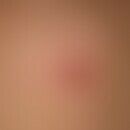DefinitionThis section has been translated automatically.
Hyaline (from the Greek hyalos = glass) refers to extracellular deposits of homogeneous, highly eosinophilic protein substances through which light shines under the microscope.
Hyaline can resemble amyloid, but in contrast to amyloid, these are heterogeneous protein substances (e.g. hyaline degeneration of collagen fibers, "hyaline bodies or so-called cytoid bodies" in lupus erythematosus or lichen planus).
ClassificationThis section has been translated automatically.
There are different types of hyaline:
- Connective tissue hyaline e.g. degenerated collagen
- Epithelial hyaline e.g. hyaline corpuscles in lichen planus
- Hyaline plaques: e.g. in the peritoneum, the pleura or the spleen capsule ("sugar icing spleen")
- Haematogenic hyaline e.g. plasma proteins, old macrothrombi, hyaline
- Vascular hyaline e.g. plasma proteins that are deposited on the walls and in the lumens of small vessels (arterioles and capillaries) or in the kidney (arteriolosclerosis).
In dermatology, the disease group of "hyalinoses" is so named because it is characterized by hyaline deposits in skin and mucous membranes (hyalinosis cutis et mucosae).



